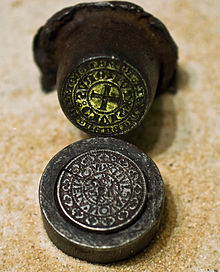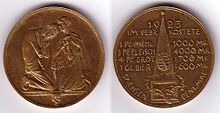Medalist


The medalist (also iron digger, iron cutter, die cutter) is an artist who designs medals , plaques or coins and often carries them out himself. The execution takes place as a stamp for an embossing or as a casting.
Explanation
The coin image was originally "dug inwards" by the coin engraver directly, that is, deepened and mirrored, into the coin iron ( coin stamp ) with the graver . The earlier designations of the die cutter as iron digger and iron cutter are derived from this. The medalist, who worked for a coin in the civil service , was appointed, for example, in the Electorate of Saxony as "Elector of Saxon Mint Iron Cutter". Most of the time, the coin engravers were allowed to make medals on a private basis in order to increase their income, in addition to official orders from the state, the provision of coin and medal stamps.
The development path to becoming a coin engraver (coin medalist) was initially training as an engraver . After learning the craftsmanship, artistic training in modeling and portrait drawing was required. Most of the time they attended an art college . Before the medalist was introduced as a public servant and coin engraver at a mint, a probationary period as an auxiliary engraver was required until he was employed by the state.
Modern manufacturing processes are increasingly being used to manufacture the coin dies. After the drawing created by the artist, an enlarged plaster model is made, which is scanned with computer technology and transferred to the specified size in an engraving-milling machine. The original matrix created in this way is reworked by engravers. From the Urmatrize that is by lowering Arbeitspatrize generated with the obtained Coining their negative image again by the pressing force of a press. Nevertheless, as late as the 20th century, outstanding medalists cut medal designs directly, deepened with a burin and mirrored, into the steel die and dispensed with the existing reducer.
signature
The signatures of the medalists only became customary in the Renaissance and initially only on the medals. One of the first medals signed by the artist is, for example, the Hustaler , which was minted around 1537 to commemorate the death of the Bohemian reformer Jan Hus . Medals from the 18th and 19th centuries are most commonly signed. Signatures by the medalists on coins are still rare at that time. In the case of coins, that changed from around the middle of the 20th century, mainly with the issue of special issues, which often bear the artist's signature.
The coin and medal signature features on coins and medals, the work of the engraver by name as author . It can often be found in a hidden place on the coin or medal and must not be confused with the mintmaster's mark . A known signature of the medalist can be important for the determination of an undated coin or medal. An example of this is the signature on the Gluckhennentaler , with which the chronological classification and thus also the reason for the coinage could be proven.
literature
- Paul Arnold, Max Fischer, Ulli Arnold: Friedrich Wilhelm Hörnlein. 1873-1945. Staatliche Kunstsammlungen Dresden - Münzkabinett, Dresden 1992.
- Max Barduleck: The last years of the mint in Dresden. Catalog of works 1865 to 1911. Edited by Paul Arnold. Transpress, Berlin 1981.
- Julius Erbstein , Albert Erbstein : Discussions in the field of the Saxon coin and medal history. Published in the Hofrath Engelhardt collection. = Engelhardt / Erbstein collection. Erbstein, Dresden 1888.
- Heinz Fengler, Gerd Gierow, Willy Unger: transpress-Lexikon Numismatics. Transpress, Berlin 1976.
- Friedrich von Schrötter , Nikolaus Bauer, Kurt Regling , Arthur Suhle , Richard Vasmer , Julius Wilcke (Hrsg.): Dictionary of coinage. de Gruyter, Berlin et al. 1930 (2nd, unchanged reprint. ibid 1970).
- Wolfgang Steguweit : History of the Gotha Mint. From the 12th to the 19th century. Böhlau, Weimar 1987, ISBN 3-7400-0050-3 .
- Wolfgang Steguweit: The medal and commemorative coin of the 20th century in Germany (= The art medal in Germany. Vol. 14). Mann, Berlin 2000, ISBN 3-88609-443-X .
- Wolfgang Steguweit: European medal art from the Renaissance to the present. National Museums in Berlin - Prussian Cultural Heritage, Berlin 1995, ISBN 3-88609-379-4 .
See also
- List of medalists
- Gotha Mint / Coin engravers of the Gotha Mint (list) were also the creators of important artistic medals
- Dresden Mint / Coin engravers of the Dresden Mint (list) were also the creators of important artistic medals
Web links
- Production, die . State Mint Berlin
- Embossing stamp . Swiss Confederation